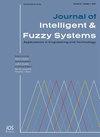Opt_att-GANC: Fusion of CT and PET images using an optimal attention-based generative adversarial network with classifier for lung cancer classification
IF 1
4区 计算机科学
Q3 COMPUTER SCIENCE, ARTIFICIAL INTELLIGENCE
引用次数: 0
Abstract
Lung cancer incidence and mortality continue to rise rapidly around the world. According to the American Cancer Society, the five-year survivability for individuals in the metastasis phases is significantly lower, highlighting the importance of early lung cancer diagnosis for effective therapy and improved quality of life. To achieve this, it is crucial to combine PET’s sensitivity for recognizing abnormal regions with CT’s anatomical localization for evaluating PET-CT images in computer-assisted detection implementations. Current PET-CT image evaluation methods either run each modality independently or aggregate the data from both, but they often overlook the fact that different visual features encode different types of data from different modalities. For instance, high atypical PET uptake within the lungs is more crucial for identifying tumors compared to physical PET uptake in the heart. To address the challenges of fine-grained issues during feature extraction and fusion, we propose an interpretable deep learning-based solution for lung cancer diagnosis using CT and PET images. This involves building an Optimal Adversarial Network for merging and an Optimal Attention-based Generative Adversarial Network with Classifier (Opt_att-GANC) to augment the classification of the existence and nonexistence of lung cancer based on extracted features. The performance of the Opt_att-GANC is compared with existing methodologies like global-feature encoding U-Net (GEU-Net), 3D Dense-Net, and 3D Convolutional Neural Network Technique (3D-CNN). Results show that the proposed Opt_att-GANC achieves an F1-score of 67.08%, 93.74% accuracy, 92% precision, 92.1% recall, and 93.74% recall. The prospective study aims to enhance the precision degree with reduced duration by incorporating an ensemble neural network paradigm for feature extraction.opt_at - ganc:使用基于最优注意力的生成对抗网络与分类器融合CT和PET图像用于肺癌分类
肺癌的发病率和死亡率在世界各地继续迅速上升。根据美国癌症协会(American Cancer Society)的数据,处于转移期的个体的5年生存率明显较低,这突出了早期肺癌诊断对有效治疗和改善生活质量的重要性。为了实现这一目标,将PET识别异常区域的敏感性与CT的解剖定位相结合,以评估计算机辅助检测实现中的PET-CT图像,这一点至关重要。目前的PET-CT图像评估方法要么独立运行每种模态,要么将两者的数据聚合在一起,但它们往往忽略了不同的视觉特征对不同模态的不同类型数据进行编码的事实。例如,与心脏的物理PET摄取相比,肺内高非典型PET摄取对识别肿瘤更重要。为了解决特征提取和融合过程中细粒度问题的挑战,我们提出了一种基于可解释的深度学习的解决方案,用于使用CT和PET图像进行肺癌诊断。这包括构建一个用于合并的最优对抗网络和一个基于最优注意力的带有分类器的生成对抗网络(Opt_att-GANC),以增强基于提取特征的肺癌存在和不存在的分类。opt_at - ganc的性能与现有的全局特征编码U-Net (GEU-Net)、3D Dense-Net和3D卷积神经网络技术(3D- cnn)等方法进行了比较。结果表明,该算法的准确率为67.08%,准确率为93.74%,精密度为92%,召回率为92.1%,召回率为93.74%。前瞻性研究的目的是通过集成神经网络模式来提高特征提取的精度和缩短时间。
本文章由计算机程序翻译,如有差异,请以英文原文为准。
求助全文
约1分钟内获得全文
求助全文
来源期刊

Journal of Intelligent & Fuzzy Systems
工程技术-计算机:人工智能
CiteScore
3.40
自引率
10.00%
发文量
965
审稿时长
5.1 months
期刊介绍:
The purpose of the Journal of Intelligent & Fuzzy Systems: Applications in Engineering and Technology is to foster advancements of knowledge and help disseminate results concerning recent applications and case studies in the areas of fuzzy logic, intelligent systems, and web-based applications among working professionals and professionals in education and research, covering a broad cross-section of technical disciplines.
 求助内容:
求助内容: 应助结果提醒方式:
应助结果提醒方式:


